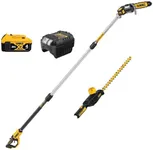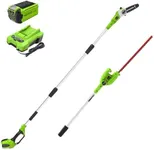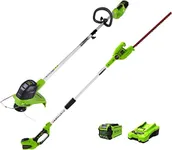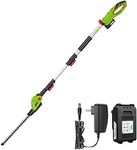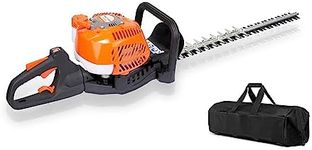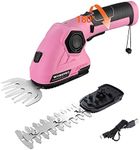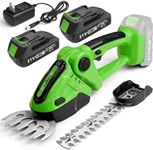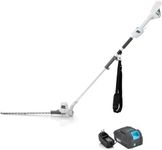Buying Guide for the Best Electric Pole Hedge Trimmers
Choosing the right electric pole hedge trimmer can make your gardening tasks much easier and more efficient. These tools are designed to help you trim and shape hedges and shrubs that are out of reach without the need for a ladder. When selecting an electric pole hedge trimmer, it's important to consider several key specifications to ensure you get the best fit for your needs. Understanding these specs will help you make an informed decision and find a trimmer that suits your gardening requirements.Power SourceElectric pole hedge trimmers can be either corded or cordless. Corded trimmers are powered by electricity from an outlet, providing consistent power without the need to recharge. They are ideal for smaller gardens where an extension cord can easily reach. Cordless trimmers, on the other hand, are battery-powered, offering greater mobility and convenience, especially for larger gardens or areas without easy access to power outlets. When choosing between the two, consider the size of your garden and how much freedom of movement you need.
Blade LengthThe blade length of a hedge trimmer determines how much hedge you can cut in one pass. Blade lengths typically range from 16 to 24 inches. Shorter blades (16-18 inches) are easier to maneuver and control, making them suitable for smaller hedges and detailed work. Longer blades (20-24 inches) can cover more area quickly, which is beneficial for larger hedges. Choose a blade length based on the size and type of hedges you have in your garden.
Pole LengthThe pole length of an electric pole hedge trimmer affects how high you can reach without a ladder. Pole lengths can vary from 6 to 10 feet or more. A longer pole allows you to trim taller hedges and shrubs with ease, but it can also make the trimmer harder to control and heavier to handle. If you have tall hedges, opt for a longer pole, but if your hedges are of moderate height, a shorter pole may be more manageable.
WeightThe weight of the trimmer is an important factor, especially if you plan to use it for extended periods. Heavier trimmers can be more tiring to use and harder to maneuver, particularly when working at height. Lighter trimmers are easier to handle and reduce fatigue, but they may have less power or shorter battery life. Consider your physical strength and the duration of your trimming tasks when choosing the weight of your trimmer.
Cutting CapacityCutting capacity refers to the maximum branch thickness the trimmer can handle. This is usually measured in millimeters or inches. A higher cutting capacity allows you to trim thicker branches, which is useful for overgrown or woody hedges. For regular maintenance of well-kept hedges, a lower cutting capacity may suffice. Assess the thickness of the branches in your garden to determine the appropriate cutting capacity for your needs.
AdjustabilitySome electric pole hedge trimmers come with adjustable heads or poles, allowing you to change the angle of the blade or the length of the pole. This feature can make it easier to reach awkward spots and trim at different angles. If your garden has hedges with varying shapes and heights, an adjustable trimmer can provide greater versatility and ease of use.
Safety FeaturesSafety features are crucial when using any power tool. Look for trimmers with features such as a safety switch to prevent accidental starts, blade guards to protect your hands, and a shoulder strap to help distribute the weight evenly. These features can help prevent accidents and make the trimmer more comfortable to use. Prioritize safety features to ensure a safe and pleasant trimming experience.

